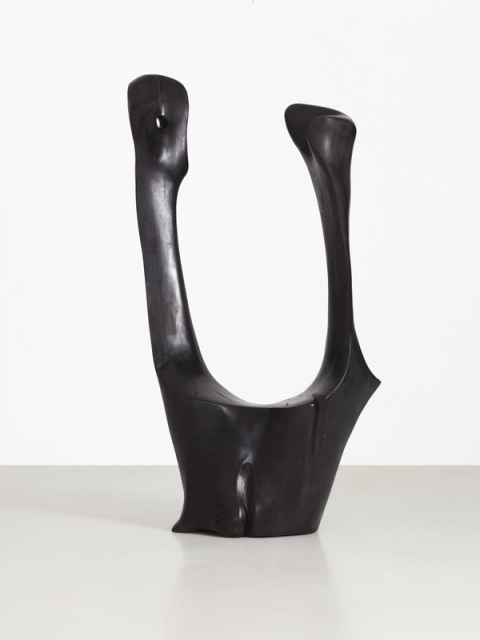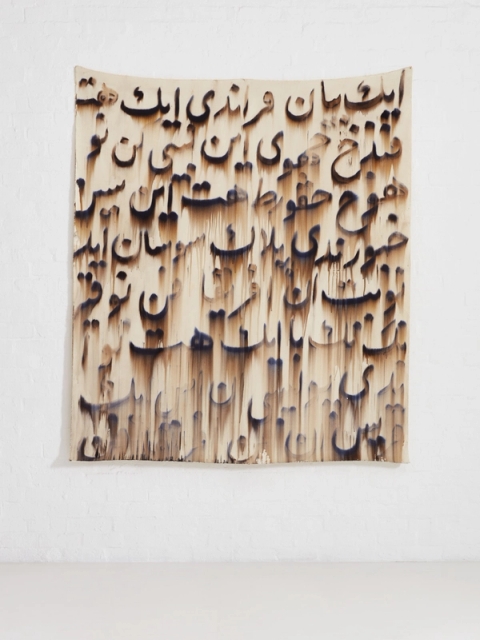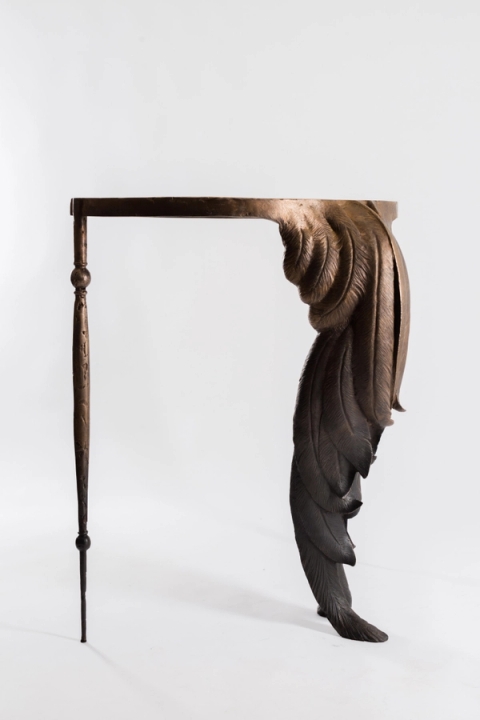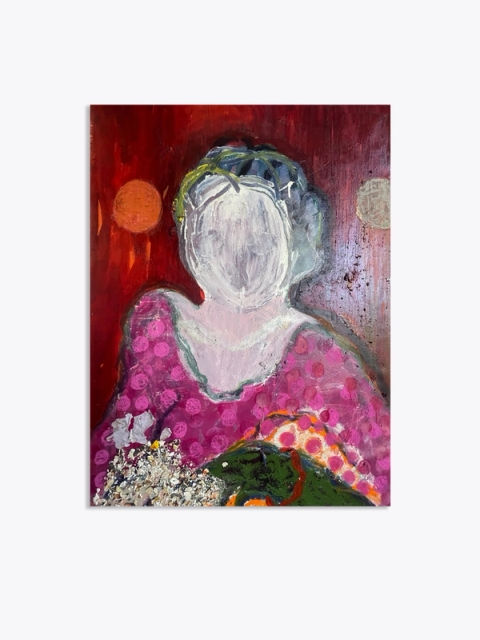My Enquiry (0)
No artwork has been selected.
Please choose an artwork to enquire.
Enquiry Submitted
Thank you for your enquiry and interest in our artists’ work. A member of the gallery team will respond shortly.
000%
19 Mar - 30 Sep 2023
On Lines and Lineage, a group exhibition at Cavalli Estate in the Cape Winelands, trails the conscious and subconscious stories we expound on through our ancient use of line. Curated by Jana Terblanche, it brings together contemporary art and collectible design by artists working in diverse media.
On Lines and Lineage investigates line as a physical marker of presence, tracing connections between formal and familial ties. Excavations at Blombos Cave in Stilbaai on the Southern Cape coast uncovered the earliest known abstract rock drawing by Homo sapiens. The 73,000-year-old rock fragment inscribed with a cross-hatch pattern in red ochre crayon points to early man’s creative urge to mark and make real both our intimate and collective narratives.
The energetic marks at play in Christine Jacobs’ charcoal drawings map sites of memory and retrace the constructed histories of her childhood landscape on her family’s sheep farm in the Free State. For Jacobs, the landscape is an “epidermis which collects data or traces of what it has hosted and engulfed”. Similarly, Adam Birch’s functional timber sculptures bear the direct biological traces of each tree’s twisting forms, magnifying the unique character of each fork through his own intervention. Scooping out sections of wood, he refines the profiles of the remaining limbs to create dynamic lines and reveal the timber’s grain.
Reverence for the natural world is a continuous thread throughout the work on show. Sculptor Otto du Plessis finds the articulated forms and arrangement of bones in an ostrich skeleton lend themselves to the creation of a cage-like light fixture. The Hok Chandelier is expertly naturalistic even as it distorts reality by deploying the bones in repeated formations. The peculiar landscape of the Northern Cape inspires the rugged fluidity of Martine Jackson’s earthenware sculpture, Detour, and the organic textures and shapes of Andile Dyalvane’s ceramic and forged copper work whose title, Ihobo-hobo, refers to the Cape weaver bird.

In Kamyar Bineshtarigh’s Factory Wall and Studio Wall series, walls serve as a breathing record of the passing of time. In these palimpsestic works, the Iranian-born artist responded to found marks on the walls of his workspace by layering his own intuitive language of marks echoing the Farsi calligraphy practised by his father and uncle. Galia Gluckman’s work, Evocation, also interlaces contemporary abstraction with personal history. Her methodically crafted work, made from thousands of pieces of cut paper, emanates from an intense engagement with making that stretches back to her maternal grandparents’ knitting factory in Czechoslovakia before the Second World War. Her use of disjointed lines to create raised, mountainous surfaces hints at her familial history of migration and fragmentation.
Dominque Zinkpè’s practice is directly influenced by Beninese folklore and East African totems. His sculptural forms, as evident in Living Spirit, are constructed from layering carved wooden Ibeji dolls that evoke the Yoruba concept of twinship. In Zimelegeqe (Standing on My Own), ceramic artist Madoda Fani enacts his unique, patterned mark-making technique inspired by the exoskeletons of insects. His visual language straddles the prehistoric and futuristic, interlinking past and future generations.
The conjured worlds of Terence Maluleke and Navel Seakamela reverberate with ancestral and familial ties. Maluleke’s series of large-scale paintings depicts his sister and by extension, he says, himself. The lily motif transforms into origami birds taking flight, an expression of his subject’s resilience and the artist’s aspiration for her dreams to be realised. The title of Seakamela’s motho ke motho ka botho series translates to “I am because you are” – a pertinent summation of the interconnection of personhood and bloodline.
On Lines and Lineage celebrates our ability to create shared histories through line-making – telling stories that speak volumes about our cultures, revealing who we are and who we desire to be, through the simple intersplicing of lines.
Artists
- Kamyar Bineshtarigh
- Adam Birch
- Cheick Diallo
- Dokter and Misses
- Andile Dyalvane
Otto du Plessis
- Jesse Ede
- Madoda Fani
Shirley Fintz
- Jozua Gerrard
Galia Gluckman
Charles Haupt
Martine Jackson
Christine Jacobs
- Justine Mahoney
- Terence Maluleke
- Chuma Maweni
Mostaff Muchawaya
Paco Pakdoust
Trevor Potter
- Navel Seakamela
- Stanislaw Trzebinski
- Dominique Zinkpè
Rodney Band
- Patrick Bongoy
Works





Andile Dyalvane
Ihobo-hobo (Cape Weaver Bird), 2022Glazed earthenware, forged copper
43.8 x 26.4 x 24.4 in. | 111 x 67 x 62 cm
Sold

Chuma Maweni
Nonhle II (Beauty), 2022Burnished, smoke-fired earthenware
28 x 12.25 x 12.25 in. | 71 x 31 x 31 cm
Sold

Chuma Maweni
Nonhle III (Beauty), 2022Burnished, smoke-fired earthenware
27.13 x 13.38 x 13.38 in. | 69 x 33 x 33 cm
Sold

Dokter and Misses
Kassena Horseman, 2015Beech, enamel
65 x 65 x 32.63 in. | 165 x 165 x 83 cm
Edition of 8

Dokter and Misses
Hug Me Like a Python, LALA Limo Series, 2023Mild steel, marble, glass, enamel
35.38 x 86.63 x 17.75 in. | 90 x 220 x 45 cm

Jesse Ede
Lunar Console, 2018Aluminium, Malmesbury slate
45.25 x 63 x 15.75 in. | 115 x 160 x 40 cm
AP1, Variable edition of 5, 1AP



Justine Mahoney
Majesty, 2020Bronze, enamel
46.5 x 19.75 x 19.75 in. | 118 x 50 x 50 cm
Edition of 9, 2AP


Kamyar Bineshtarigh
Factory Wall XI, 2022Wall paint, ink, cold glue, on hessian backing
67.8 x 189 in. | 172 x 480 cm
Sold

Kamyar Bineshtarigh
Factory Wall Triptych, 2022Wall paint, ink, crayon, cold glue on hessian backing
110.3 x 157.5 in. | 280 x 400 cm

Kamyar Bineshtarigh
The Letter, 2021Ink, bleach, cold glue on canvas
82.6 x 71.6 in. | 210 x 182 cm

Kamyar Bineshtarigh
Untitled (Book of Tawhid I), 2021Ink, bleach, cold glue on canvas
86.6 x 82.6 in. | 220 x 210 cm
Sold

Kamyar Bineshtarigh
Untitled (Gairodien's student notebook III), 2021Ink, bleach on calico
39.4 x 78.8 in. | 100 x 200 cm

Kamyar Bineshtarigh
Untitled (Gairodien's student notebook III), 2021Ink, bleach on calico
39.4 x 78.8 in. | 100 x 200 cm

Patrick Bongoy
Desert Flower, 2023Recycled rubber inner tube, metal parts on board
81.1 x 98.4 x 8.6 in. | 206 x 250 x 22 cm


Otto du Plessis
Hok Chandelier, 2016Bronze, electrical components
106.3 x 31.5 x 31.5 in. | 270 x 80 x 80 cm

Otto du Plessis
Rooster Mirror, 2020Bronze, mirror, timber
41.4 x 35.4 x 1.1 in. | 105 x 90 x 3 cm
Edition of 9


Otto du Plessis
Hornbill Woman, Angry Birds Series, 2021Bronze
20.5 x 5.5 x 5.5 in. | 52 x 14 x 14 cm
Edition of 12

Otto du Plessis
Flamingo Woman, Angry Birds Series, 2021Bronze
20.1 x 9 x 4.4 in. | 51 x 23 x 11 cm
Edition of 12

Otto du Plessis
Peacock Woman, Angry Birds Series, 2021Bronze
24 x 6.8 x 7.5 in. | 61 x 17 x 19 cm
Edition of 12

Otto du Plessis
Peacock Woman, Angry Birds Series, 2021Bronze
24 x 6.8 x 7.5 in. | 61 x 17 x 19 cm
Edition of 12

Madoda Fani
Zimelegeqe (Standing on My Own), 2023Burnished, smoke-fired earthenware
34.63 x 17.75 x 15 in. | 88 x 45 x 38 cm
Sold

Shirley Fintz
Warrior II, The Healers Series, 2022Glazed stoneware
31.5 x 18.1 x 14.6 in. | 80 x 46 x 37 cm


Galia Gluckman
Evocation, 2022Paper, acrylic, balsa wood, board (framed)
83.5 x 55.1 x 3.1 in. | 212 x 140 x 8 cm

Charles Haupt
Num Num Dining Table II, 2020Bronze, glass
28.4 x 60.7 x 59.9 in. | 72 x 154 x 152 cm
Edition of 15










Terence Maluleke
Bloom in truth fly in virtue, 2022Acrylic on canvas
93.75 x 59.5 in. | 238 x 151 cm
Sold


Chuma Maweni
Indoni I (Berry of the Waters), 2022Burnished, smoke-fired earthenware
18.5 x 12.25 x 12.25 in. | 47 x 31 x 31 cm
Sold

Chuma Maweni
Nonhle II (Beauty), 2022Burnished, smoke-fired earthenware
28 x 12.25 x 12.25 in. | 71 x 31 x 31 cm
Sold






Paco Pakdoust
Blue Label, in collaboration with Wayne Barker, 2014Hemp, silk
110.3 x 98.4 in. | 280 x 250 cm
Edition of 5

Paco Pakdoust
Haunted In Collaboration With Conrad Botes, 2010Hand-knotted Tibetan Highland wool, silk
98.4 x 98.4 in. | 250 x 250 cm
Edition of 5

Trevor Potter
‘Egg & Dart’ - The Dart - He who fails to aim the dart risks making himself the mark, 2023Resin, marble dust, acrylic and gold leaf
25⅝ x 8¼ x 8¼ in.
Edition of 8

Trevor Potter
‘Egg & Dart’ - The Egg - She who kills the goose forsakes the egg, 2023Resin, marble dust, acrylic and gold leaf
25.6 x 8.3 x 8.3 in. | 65 x 21 x 21 cm
Edition of 8

Navel Seakamela
Motho ke motho ka botho II, 2023Acrylic, charcoal, pastel on canvas (framed)
36.6 x 3.1 in. | 93 x 82 cm

Navel Seakamela
Motho ke motho ka botho III, 2023Acrylic, charcoal, pastel on canvas (framed)
34.6 x 32.3 in. | 88 x 82 cm
Sold

Stanislaw Trzebinski
Doomsday Prepper, 2022Bronze, mirror, aluminium, steel
94.5 x 47.3 x 2.5 in. | 240 x 120 x 6.5 cm
Edition of 2

Stanislaw Trzebinski
Resonance Table 2.0, 2022Ash, epoxy, bronze, steel
30.3 x 63 x 63 in. | 77 x 160 x 160 cm
Edition of 3, 1AP

Dominique Zinkpè
Dominatrice (Dominatrix), 2019Mixed media on canvas
79.9 x 79.1 in. | 203 x 201 cm


Dominique Zinkpè
Poésie Humaine, 2021Bronze, enamel
78.8 x 19.8 x 18.5 in. | 200 x 50 x 47 cm
Edition of 5






